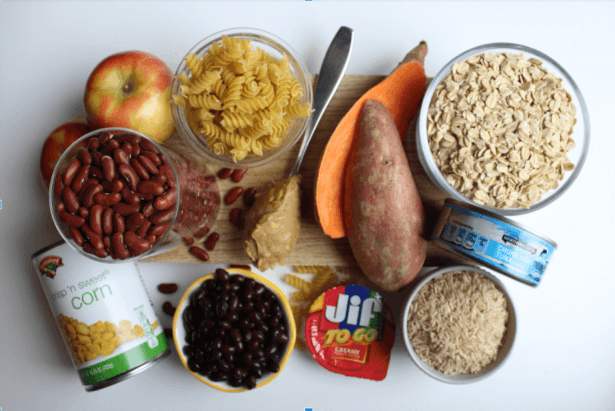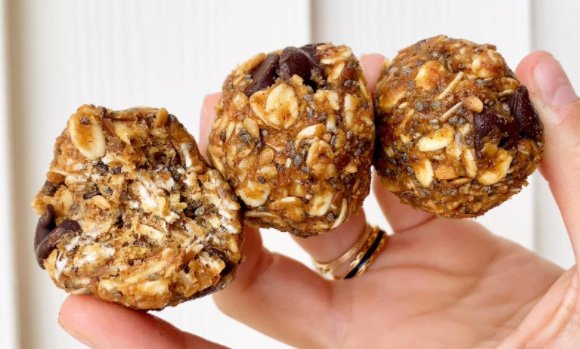Food for Thoughtful Remote Learning

A guide to pantry staples and healthy, brain-powering foods for school day snacking!
Partnered with Hayley Mielnicki, Registered Dietitian, Owner at Health By Hayl
This year has thrown us all for a loop, including our children. Routines got out of whack, mealtimes turned into snack times throughout the entire day, and certain food supplies were in shortage at times. This has made mealtimes a challenge for families across the world. Getting children to eat a balanced diet is a challenge in and of itself, but throwing a pandemic on top of that mixed with remote learning and it could be a recipe for disaster! Here are some ways to make life easier around mealtimes and snacks while powering your child’s brain and giving their bodies what they need, but in a fun way!

Pantry Staples
Pantry staples are items that have a long shelf life, are packed with nutrients, and can be used in a variety of ways. Overall, they’ll rarely go to waste and are extremely versatile.
Some common pantry staples may include apples, oats, potatoes (kids will LOVE sweet potatoes!), frozen vegetables and fruits (great for smoothies!), canned tuna or salmon, pasta, rice, canned beans, or any type of peanut or nut butter. Learn more about pantry staples and find recipes that focus on using many of these staples. Warning: Do not enter if you are hungry and don’t want to find delicious recipes such as Apple Nachos and Turkey Chili!
Now let’s move onto the main food groups that your kiddos should be having daily.
Whole Grains
A whole grain contains each part of the cereal grain including the endosperm, germ, and bran, while refined grains (such as white pasta, bread, flour) only contain the endosperm. Because each part of the grain is left intact, whole grains provide more fiber, B vitamins and zinc. To easily incorporate more whole grains into your child’s diet, focus on purchasing healthy grains such as oats, tortillas, rice, quinoa, crackers, and pastas. Look for “whole grain” on the labels for an extra bonus! These foods will give your child the energy he or she needs to get through their school days.
Some of my favorite recipes that include whole grains are pizza quesadillas, banana sushi, and overnight oats, pictured above! Click these links to travel to my YouTube channel where I teach you how to make these awesome recipes that your kids will love.

Fruits & Vegetables
As parents, is it difficult to get your kids to eat their daily requirement of fruits and vegetables? Maybe fruits are easier, given the natural sugars, but do your kids run and hide at the sight of anything green? I see you! While fresh fruits and vegetables are preferred, frozen or canned fruits and vegetables offer a longer shelf life, and most often quicker preparation. Preserved fruits and vegetables still contain vital nutrients like vitamins and minerals. When buying frozen fruits and vegetables, look for those with minimal added ingredients such as sugar, salt, or other preservatives. Try buying low sodium canned vegetables and look for canned fruits packed in just water. Check out my recipes for PB&J smoothies and sweet potato chili for an easy way to sneak fruits and veggies into your child’s diet without a fight! You can also offer your children snacks such as applesauce, fruit cups, or dried fruit to easily get their servings of fruit out of the way during snack times.

Proteins
Nuts, nut butter and seeds are full of healthy, mono and polyunsaturated fats that are essential for brain and bone health. In case of an allergy, try sunflower seed butter or cashew butter as an alternative as both of these offer the same nutritional value as peanut butter. Canned fish can not only be convenient for quick sandwiches and wraps, but they also offer an immense amount of protein, Omega 3s (essential fatty acids), Vitamin D and selenium. Look for canned fish with minimal added sodium and preservatives, and those that are canned in water or olive oil. Dried beans can be significantly cheaper than canned, but do take longer to prepare. Beans in general are a great source of fiber (that keeps our digestion regular), protein, and iron. Protein can be an easy nutrient to add into any of your child’s meals. Start by trying recipes like homemade granola bars and apple donuts!
Sweets
If you have children, chances are you have no trouble getting sweets and sugars into their bodies as these are typically foods that are crowd pleasers! While we don’t want our kids filling up on empty calories and processed foods, you can add honey, maple syrup, or chocolate chips to easily sweeten other foods that you want them to eat. Honey pairs great with many fruits and even vegetables, and throwing a few semisweet chocolate chips on top of a nutritious breakfast can convince your kids that it is the most important meal of the day!
I hope these tips and tricks for incorporating the many food groups that your child needs to power through the day has been helpful!
All recipes that are listed within this blog are available on healthbyhayl.com, on Facebook at Farm to School Mohawk Valley, or on YouTube at OHM Dietitian. Check out these sites for more information and frequent updates as seasons change to keep mealtimes and snack times fun!
__________________________________________________________
Hayley Mielnicki is a peanut butter lover, chef and Registered Dietitian that currently works for Oneida-Herkimer-Madison BOCES, creating the breakfast and lunch menus for 16 school districts in Central New York. Hayley shares simple, versatile recipes (on her website healthbyhayl.com and Instagram @healthbyhayl) that any home chef can conquer!
